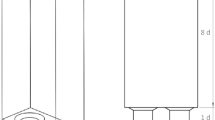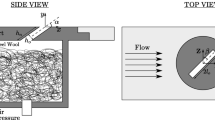Abstract
The objective of this study was to demonstrate and analyze empirical model results for jet-in-crossflow configurations which are typical in gas turbine combustors. Calculations in this paper, for opposed rows of round holes in both inline and staggered arrangements, were made with an Excel® spreadsheet implementation of a NASA-developed empirical model for the mean conserved scalar field. Results for cases of opposed rows of jets with the orifices on one side shifted by half the orifice spacing shows that staggering can improve the mixing, particularly for cases that would overpenetrate if the orifices were in an aligned configuration. For all cases investigated, the dimensionless variance of the mixture fraction decreased significantly with increasing downstream distance. The variation between cases at a given downstream location was smaller, but the “best” mixers for opposed rows of jets were found to be inline and staggered arrangements at an orifice spacing that is optimum for inline jets.










Similar content being viewed by others
Abbreviations
- A J /A M :
-
Jet-to-mainstream area ratio = (π/4)/((S/H)(H/d)2)
- C :
-
(S/H)(sqrt (J)) same as Eq. 3
- C d :
-
Orifice discharge coefficient = (effective area)/(physical area)
- d :
-
Actual physical diameter of a round hole
- DR :
-
Jet-to-mainstream density ratio, ρ J /ρ M
- H :
-
Duct height (called H 0 in several previous publications)
- H/d :
-
Ratio of duct height to orifice diameter
- H eq :
-
Effective duct height = H in this paper
- H 0 :
-
Duct height at axial location of jet center
- J :
-
Jet-to-mainstream momentum-flux ratio, (ρ J V 2 J )/(ρ Μ U 2 M )
- JIC :
-
Jet(s) in crossflow
- m J :
-
Jet mass flow
- m M :
-
Mainstream mass flow
- m T :
-
Total mass flow, m J + m M
- MR :
-
Jet-to-mainstream mass-flow ratio = m J /m M = (ρ J /ρ M )(V J /U M )(C d )(A J /A M )
- m J /m T :
-
Jet-to-total mass-flow ratio
- S :
-
Lateral spacing between equivalent locations of adjacent orifices, e.g. between orifice centerplanes
- S/d :
-
Ratio of orifice spacing to orifice diameter = (S/H)(H/d)
- S/H :
-
Ratio of orifice spacing to duct height
- S X /H :
-
Ratio of axial orifice spacing between rows to duct height
- T :
-
Local scalar variable
- T J :
-
Scalar variable at jet exit
- T M :
-
Scalar variable in unmixed mainstream flow
- U :
-
Axial velocity
- U M :
-
Unmixed mainstream velocity
- U s :
-
Unmixedness = θvar/(θave(1 − θave)); same as Eq. 2
- V J :
-
Jet exit velocity
- x :
-
Downstream coordinate; x = 0 at center of the first row of orifices
- y :
-
Cross-stream coordinate; y = 0 at wall
- y c :
-
Scalar trajectory, location of maximum scalar difference ratio, θ c
- z :
-
Lateral coordinate
- θ:
-
Dimensionless scalar, (T M − T)/(T M − T J ); same as Eq. 1
- θ ave :
-
Fully-mixed scalar difference ratio ~m J /m T
- θ c :
-
Maximum scalar difference ratio, defines location of scalar trajectory, y c /H
- θ var :
-
Variance of scalar difference ratio
- ρ J :
-
Density of jet flow
- ρ M :
-
Density of mainstream flow
References
Holdeman JD (1993) Mixing of multiple jets with a confined subsonic crossflow. Prog Energy Combust Sci 19:31–70. doi:10.1016/0360-1285(93)90021-6 (similar to AIAA paper 91-2458 and NASA TM 104412, June 1991)
Holdeman JD, Liscinsky DS, Oechsle VL, Samuelsen GS, Smith CE (1997) Mixing of multiple jets with a confined subsonic crossflow: part I—cylindrical ducts. J Eng Gas Turbines Power 119(10):852–862. doi:10.1115/1.2817065 (same as ASME paper 96-GT-482 and NASA TM 107185, June 1996)
Holdeman JD, Liscinsky DS, Bain DB (1999) Mixing of multiple jets with a confined crossflow: part II—opposed rows of orifices in rectangular ducts. J Eng Gas Turbines Power 121(7):551–562. doi:10.1115/1.2818508 (same as ASME paper 97-GT-439 and NASA TM 107461, June 1997)
Holdeman JD, Vardakas MA, Chang CT (2008) Mixing of multiple jets with a confined subsonic crossflow: part III—the effects of air preheat and number of orifices on flow and emissions in an RQL mixing section. NASA/TM—2008-215151, March (similar to J Fluids Eng 129(11):1460–1467, Nov 2007; derived from NASA TM-1999-209431, September 1999)
Holdeman JD, Smith TD, Clisset JR, Lear WE (2005) A spreadsheet for the mixing of a row of jets with a confined crossflow. NASA/TM—2005-213137, February
Holdeman JD, Clisset JR, Moder JP, Lear WE (2006) On the mixing of single and opposed rows of jets with a confined crossflow. NASA/TM—2006-214226, October
Holdeman JD, Clisset JR, Moder JP (2010) Spreadsheet calculations for jets in crossflow: opposed rows of inline and staggered holes and single and opposed rows with alternating hole sizes. NASA/TM—2010-216100, July
Liscinsky DS, True B, Holdeman JD (1996) Effect of inlet flow conditions on crossflow jet mixing. AIAA paper 96-2881 (same as NASA TM 107258), July
Kobayashi H, Ham F, Wu X (2008) Application of a local SGS model based on coherent structures to complex geometries. Int J Heat Fluid Flow 29:640–653. doi:10.1016/2008.02.008
Acknowledgments
The authors would particularly like to thank Mr. Richard E. Walker (Aerojet Liquid Rocket Company, ret.) and Dr. Ram Srinivasan (then of Garrett Turbine Engine Company) for their contributions to the NASA JIC empirical model, and to Professor William E. Lear of the University of Florida for suggesting that the original computer code, written in the 1980s on a 64K Apple//e® in Applesoft® BASIC accompanied by a HyperCard® slideshow, could be rendered in an Excel® spreadsheet and for directing the development of the JIC spreadsheet.
Author information
Authors and Affiliations
Corresponding author
Rights and permissions
About this article
Cite this article
Holdeman, J.D., Clisset, J.R. & Moder, J.P. Spreadsheet calculations of jets in crossflow: opposed rows of inline and staggered round holes. Heat Mass Transfer 48, 413–424 (2012). https://doi.org/10.1007/s00231-011-0913-6
Received:
Accepted:
Published:
Issue Date:
DOI: https://doi.org/10.1007/s00231-011-0913-6




